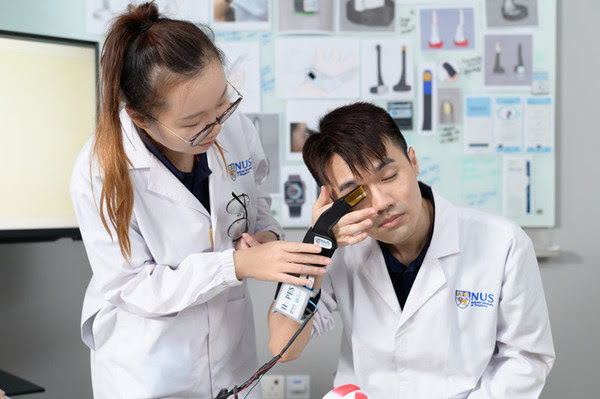A home eye pressure testing device
Kelu Yu’s father was diagnosed with glaucoma and seeing a gap for a less invasive and accessible method to test, she came up with a solution.

Team members of HOPES: From the left, David Lee, Kelu Yu and Li Si.
In late 2019, Kelu Yu’s father was diagnosed with glaucoma. He suffered from constant eye pain and headaches, having to visit the doctor for eye pressure tests lasting whole days. The uncomfortable treatment and frequent hospital visits deeply impacted Kelu and motivated her to better understand the disease.
She realised there is a global need for a less invasive and more accessible method for Intraocular Pressure (IOP) monitoring. That spurred Kelu who comes from China to come out with HOPES (Home eye Pressure E-skin Sensor), a wearable biomedical device, with her team, Si Li from China and David Lee from Singapore, and winning the James Dyson Award International prize 2021.
Glaucoma is the second leading cause of blindness worldwide. In 2020, about 80 million people have glaucoma worldwide, and this is expected to rise to over 111 million by 2040. In Singapore, approximately three percent of people over the age of 50 have glaucoma. This percentage increases with age and reaches almost 10 percent for those over the age of 70. Because it is largely symptom-free, it’s also known as the “silent thief of sight”. There is no cure but, if diagnosed and treated early, blindness can be prevented.

A demonstration of how HOPES works.
Today, regular IOP monitoring is a critical tool in helping clinicians determine long-term treatment plans and goals. This is achieved through the Goldmann Applanation Tonometry – regarded as the gold standard for the measurement of IOP. There is a demand for safe, accurate, low-cost, at-home IOP measurement devices to better improve the patient experience.
HOPES is a device for pain-free, low cost, at-home IOP testing. Powered by patent pending sensor technology and artificial intelligence, HOPES is a convenient device for users to frequently self-monitor IOP.
After creating a profile in the app, the user wears the HOPES glove with the sensor placed at the fingertip, pressing this against the centre of the eyelid. The fingertip employs a unique sensor architecture that captures dynamic pressure information of the user’s eye with sub-millisecond precision. The captured signals are processed by machine learning algorithms to continuously and accurately compute users’ IOP.

HOPES – a cost-effective wearable bio-medical device that enables the measurement of intraocular pressure at home in a comfortable manner.
Data is transmitted via Bluetooth to paired devices or uploaded to the Cloud to be accessed remotely by clinicians. The app prompts users with easy-to-read measurement history and direct links to healthcare systems, allowing them to seek medical help to minimise future symptoms. The team have since spent the past 18 months designing, ideating and prototyping HOPES.
“I’ve experienced first-hand how invasive and unpleasant the tests for glaucoma can be, but it is a vital test. This group of young people have tackled a problem that doesn’t affect them directly, but which affects members of their family. Their work has the potential to make glaucoma testing much more widely available,” said Sir James Dyson, founder and chief engineer at Dyson. Kelu’s team who are past and present students of the National University of Singapore win £30,000 in prize money to support them in the next stages of their invention. The team is focusing on improving the machine learning model, optimising the app and working with local hospitals in Singapore to pilot HOPES.
(** PHOTO CREDITS: James Dyson Foundation)

0 Comments